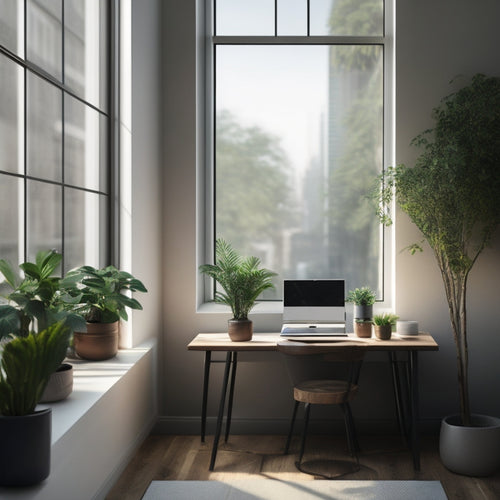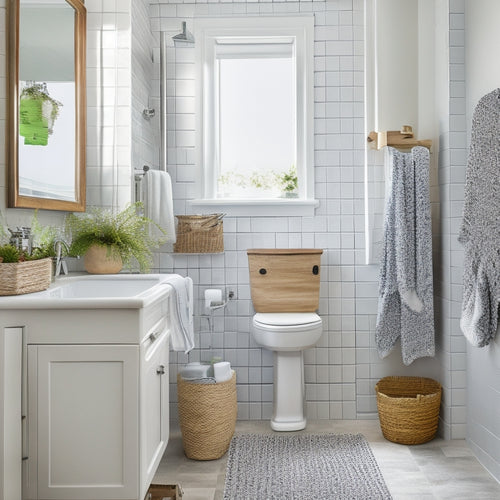
What Storage Solutions Work Best for Big Families?
Share
To create effective storage solutions for your big family, start by evaluating your family's unique needs and habits. Conduct a storage audit to identify clutter areas and determine the best storage solutions, such as shelves, cabinets, or customizable closet designs. Utilize vertical space in high-traffic areas with coat hooks, key holders, and shelves. Implement adaptable storage solutions like modular shelving units and stackable plastic bins to accommodate changing needs. Designate specific areas for each family member's belongings and establish rules for maintaining shared spaces. With these strategies, you'll be well on your way to a more organized, clutter-free home - and that's just the beginning.
Key Takeaways
• Create a family profile to identify clutter areas and determine needed storage solutions based on family members' habits and interests.
• Designate specific areas for each family member's belongings and implement Room Zoning for shared spaces to encourage ownership and organization.
• Utilize vertical space for storage in high-traffic areas and install shelves, cabinets, and hooks to maximize space and keep clutter at bay.
• Invest in flexible furniture and modular systems that can adapt to evolving needs, such as stackable plastic bins and ottomans with storage.
• Use clear language and bold fonts for labeling, and implement color coding and icons for easy recognition to maintain organized spaces.
Assessing Your Family's Storage Needs
Take stock of your family's belongings and habits to identify the areas where storage solutions can make the biggest impact. This is vital in creating a tailored approach to your storage needs.
Start by creating a family profile, which includes the number of family members, their ages, and their interests. This will help you understand what type of storage solutions you need. For instance, if you have young children, you may need more storage for toys and educational materials.
Next, conduct a storage audit to identify the areas in your home where clutter tends to accumulate. Walk through each room, taking note of what's working and what's not. Make a list of the items you need to store and the frequency of use. This will help you determine the type of storage solutions you need, such as shelves, cabinets, or bins.
Maximizing Space in High-Traffic Areas
As you navigate your busy household, you know that high-traffic areas like hallways and entry points can quickly become cluttered.
To keep these spaces organized and functional, you'll want to focus on maximizing every inch of available space.
Hallway Hooks and Shelves
You can quickly create a sense of organization in your hallway by installing hooks and shelves that capitalize on the often-wasted vertical space. This is especially important in high-traffic areas where clutter can easily accumulate. By utilizing hallway hooks and shelves, you can create a functional and stylish space that keeps your family's essentials within easy reach.
Here are some ideas for maximizing your hallway's potential:
| Storage Solution | Benefits | Tips |
|---|---|---|
| Coat Hooks | Keeps coats, hats, and bags off the floor | Install at a comfortable height for your family members |
| Key Holders | Designated spot for keys, reducing clutter | Consider adding a small tray or dish for spare change |
| Shelves for Baskets | Stores items like gloves, scarves, and mail | Label each basket for easy identification |
| Hooks for Backpacks | Keeps backpacks organized and off the floor | Install near the entrance for easy access |
| Shelf for Shoes | Stores shoes, keeping them organized and out of the way | Consider adding a small bench or stool for putting on/taking off shoes |
Streamlining Entry Points
By extending your organizational efforts to the entry points of your home, you can create a seamless flow from the hallway to the rest of the house, making it easier for your family to come and go. This is especially important in high-traffic areas like the foyer, where clutter and chaos can quickly accumulate.
To streamline your entry points, consider the following strategies:
-
Choose functional foyer furniture: Select pieces that provide storage, such as benches with built-in cubbies or consoles with drawers, to keep essentials like keys, wallets, and bags organized.
-
Establish entry routines: Designate a specific spot for each family member to place their belongings, and encourage everyone to follow the routine to maintain a sense of order.
-
Designate a 'launching pad': Identify a specific area, such as a hook or tray near the door, where family members can place their belongings as they come and go, keeping clutter at bay.
Optimizing Corner Spaces
Corner spaces in high-traffic areas, such as mudrooms or hallways, can be transformed into valuable storage hubs with the right strategies. You can start by installing corner shelving units that maximize vertical space, providing ample storage for backpacks, jackets, and other essentials.
To make the most of the available space, consider curved cabinets that fit snugly into the corner, offering a seamless and stylish storage solution.
When selecting corner shelving, look for units with adjustable shelves and baskets to accommodate items of varying sizes. You can also add hooks, bins, or baskets to keep items organized and within easy reach.
For a more customized approach, consider installing a built-in corner shelving system that's tailored to your family's specific needs.
Customized Closets for Each Child
When it comes to your kids' closets, you want to create a space that's both functional and personalized to their unique needs. By designing customized closets for each child, you'll be able to provide them with their own tailored storage solutions that make sense for their individual styles.
With features like personalized storage spaces, easy access design, and customized shelf dividers, you'll be helping your kids develop good organizational habits from a young age.
Personalized Storage Spaces
You can create a sense of ownership and responsibility among your kids by designing customized closets that cater to each child's unique needs and preferences. This approach allows them to take pride in their personal space and encourages them to maintain organization and tidiness. By incorporating their input in the design process, you'll create a space that reflects their personality and style.
Here are three ways to make their closets truly personalized:
-
Display Family Heirlooms: Designate a special section for family heirlooms, such as grandma's antique jewelry box or grandpa's vintage sports jersey. This will help your kids connect with their family's history and heritage.
-
Incorporate Personal Expression: Add a few decorative elements that reflect your child's interests, hobbies, or passions. For example, if they love music, consider adding a guitar-shaped coat hook or a music-inspired wallpaper.
-
Use Colorful Accents: Let your kids choose their favorite colors for the closet's walls, shelves, or accessories. This will make their space feel truly their own and add a pop of personality to the room.
Easy Access Design
Designing customized closets with easy access in mind allows each child to effortlessly retrieve and store their belongings, making morning routines smoother and reducing clutter buildup. You'll want to create an open layout that lets your kids easily see and reach their clothes, shoes, and accessories. This is especially important for younger children who may have difficulty moving through tight spaces or dealing with complex storage systems.
Floating shelves can be a great addition to your customized closets. They provide ample storage for folded clothes, bins, or baskets, and can be installed at a height that's accessible to each child. You can also use them to create separate areas for different types of items, like a shelf for dresses or one for outerwear.
Customized Shelf Dividers
By incorporating customized shelf dividers into each child's closet space, you can further personalize their storage areas and help them develop a sense of ownership and responsibility for their belongings. This tailored approach to shelf organization enables you to create a unique divider system that caters to each child's specific needs and preferences.
Here are three benefits of customized shelf dividers:
-
Efficient Use of Space: Customized dividers guarantee that every available inch of closet space is utilized, keeping clutter at bay and making it easier for your kids to find what they need.
-
Easy Maintenance: With designated areas for different items, your kids can maintain their closet spaces with ease, promoting a sense of responsibility and independence.
-
Personalized Style: Customized shelf dividers allow your kids to express their individuality, making their closet spaces a reflection of their unique personalities.
Creative Uses for Vertical Space
Shelves and storage units that optimize ceiling height can be installed to tap into the potential of your home's often-wasted vertical space. This is especially useful for big families, where every inch counts. By utilizing wall shelves and ceiling storage, you can free up floor space and create a more open, airy feel in your home.
Consider installing floor-to-ceiling shelves in your pantry, closet, or living room. These can hold a wide range of items, from books and decorative objects to kitchen utensils and linens. You can also add baskets, bins, or containers to store items like toys, craft supplies, or out-of-season clothing.
Ceiling storage is another great option. You can install overhead shelves or racks to store items like luggage, camping gear, or infrequently used appliances. This keeps them out of the way but still easily accessible when you need them.
Coordinating Storage for Shared Rooms
When you're dealing with shared rooms in a big family, assigning personal storage spaces to each family member can help maintain harmony and reduce clutter. This is especially important in rooms where multiple kids share the same space. By giving each child their own designated area, you can encourage them to take ownership of their belongings and keep their stuff organized.
To achieve this, consider implementing Room Zoning. This involves dividing the room into separate areas, each designated for a specific activity or person. This can help create a sense of Shared Sanity and reduce conflicts over shared spaces.
Here are some tips to get you started:
-
Designate a specific area for each child's belongings, such as a dresser or bookshelf, to help them keep their things organized.
-
Use storage bins and baskets to keep clutter at bay and make it easy for kids to find what they need.
-
Establish rules and routines for maintaining the space, such as daily tidy sessions or weekly deep cleans, to keep the room looking its best.
Labeling and Signage for Easy Access
When thinking about labeling, it's crucial to take into account the psychology behind it. Using clear, concise language and bright, bold fonts can grab your kids' attention and make them more likely to follow the system.
Color coding is another effective strategy to implement. Assigning a specific color to each category (e.g., toys, clothes, books) creates a visual hierarchy that's easy to follow. You can also use icons or images to help younger kids recognize what's inside the bin.
Functional Zones for Family Hubs
By dividing your home into functional zones, you can create hubs that cater to your family's specific needs, streamlining daily routines and making the most of your available space. This zone designation approach allows you to allocate areas for different activities, making it easier for everyone to find what they need when they need it.
Here are three ways to create functional zones in your home:
-
Family Gathering Zone: Designate a specific area for family bonding, such as a game room or media room. This zone can be equipped with storage solutions like shelving units, cabinets, or ottomans to keep toys, games, and entertainment devices organized.
-
Morning Launch Zone: Create a zone near the entrance of your home where family members can prepare for their day. This can include a bench for putting on shoes, a table for breakfast, and storage for backpacks, lunchboxes, and other essentials.
-
Homework Zone: Designate a quiet area for kids to do their homework, equipped with storage solutions like desks, bookshelves, and supply organizers to keep materials within reach.
Hiding Clutter With Decorative Storage
You can cleverly conceal cluttered areas with decorative storage solutions that serve a dual purpose: beautifying your space while keeping essentials hidden from view. This approach allows you to maintain a sense of organization and style, even in high-traffic areas.
Here are some ideas to get you started:
| Decorative Storage Solution | Description | Benefits |
|---|---|---|
| Hidden Baskets | Woven or fabric baskets that blend with your decor | Conceals clutter, adds texture and warmth |
| Style Shelves | Floating shelves with decorative brackets | Displays decorative items, keeps essentials within reach |
| Ottoman Storage | Upholstered ottomans with storage compartments | Provides seating, hides clutter, and adds style |
| Decorative Trunks | Wooden or upholstered trunks with intricate designs | Stores items, serves as a coffee table or bench |
| Woven Storage Bins | Colorful, woven bins that fit under shelves or in corners | Adds a pop of color, stores small items |
Adaptable Storage for Growing Families
As your family grows, adaptable storage solutions become essential to accommodate the ever-changing needs of your household. You need storage that can evolve with your family's changing requirements, from diaper duty to teenage messes.
Flexible furniture and modular systems are ideal for big families, as they can be easily rearranged or expanded as needed.
Here are three adaptable storage solutions worth exploring:
-
Modular shelving units: These can be easily added to or rearranged as your storage needs change.
-
Ottomans with storage: They provide hidden storage for toys, blankets, or linens, and can be easily moved to different rooms.
-
Stackable plastic bins: Label them and use them to store everything from toys to out-of-season clothes, and they can be easily stacked or rearranged as needed.
Implementing a Maintenance Routine
As you set up your storage solutions, you'll want to think about how you'll maintain them over time.
You'll need to establish a routine that keeps your spaces organized and clutter-free, and that starts with daily tasks management and scheduling regular cleaning sessions.
Daily Tasks Management
Establishing a daily maintenance routine is crucial for keeping clutter at bay and freeing up time for more important activities. As a big family, prioritizing tasks is key to maintaining a sense of organization and control. You can start by implementing morning routines that set the tone for the day. This can be as simple as making your bed, putting away toys, or doing a quick 10-minute tidy.
To maximize your daily tasks management, focus on the following:
-
Task Prioritization: Identify the most critical tasks that need to be done daily, such as meal prep, homework, or laundry. Focus on completing these tasks first to free up time for other activities.
-
Designate Zones: Assign specific areas of the house to specific family members to maintain, such as the living room or kitchen. This encourages teamwork and accountability.
-
Create a 'One-Touch' Rule: Encourage family members to put things away in their designated place as soon as they're done using them. This reduces clutter and saves time in the long run.
Schedule Regular Cleaning
By allocating specific days and times for deeper cleaning tasks, you can maintain a sense of control and order in your home. This is especially important for big families, where clutter and mess can quickly get out of hand.
Set aside one day a week for deep cleaning tasks, such as scrubbing bathrooms or reorganizing closets. Break down larger tasks into smaller, manageable chunks, and assign them to specific days or times. For example, you might dedicate Monday mornings to tidying up living areas, and Thursday afternoons to laundry and folding.
Frequently Asked Questions
How Do I Convince My Kids to Maintain Their Organized Spaces?
You create incentives, like rewards or privileges, when they maintain their organized spaces, and set boundaries, like designated cleaning times, to help them develop habits and a sense of responsibility for their belongings.
Can Storage Solutions Be Stylish and Functional at the Same Time?
You can definitely find storage solutions that are both stylish and functional by considering design elements, such as color schemes and textures, and aesthetic considerations, like the overall style of your home, to create a cohesive look.
Are There Storage Options That Can Grow With My Children's Needs?
You'll find that modular systems and expandable containers are perfect for growing families, as they adapt to your children's changing needs, providing flexible storage solutions that can be easily rearranged or added to over time.
How Do I Store Bulky Items Like Bicycles and Strollers?
"Imagine a calm sea, free from cluttered shores. You can achieve this by storing bulky items like bicycles and strollers in garage systems or outdoor sheds, freeing up space and bringing order to your chaos."
Can I Repurpose Items I Already Own for Storage Purposes?
You can breathe new life into old items by repurposing them for storage. Try turning old pallets into DIY shelves or using Creative Crates to store toys, books, and linens – it's an eco-friendly and budget-friendly solution!
Related Posts
-

Transform Your Space: 5 Online Courses to Help
Ready to transform your space from cluttered to calm? Start with mastering home organization fundamentals, like declu...
-

Organize Your Digital Photos With These Online Courses
You've accumulated thousands of digital photos, and finding a specific one has become overwhelming. It's time to orga...
-

Bathroom Storage Hacks for Small Spaces Revealed
You're about to discover the ultimate bathroom storage hacks for your small space! Start by maximizing your vertical ...


